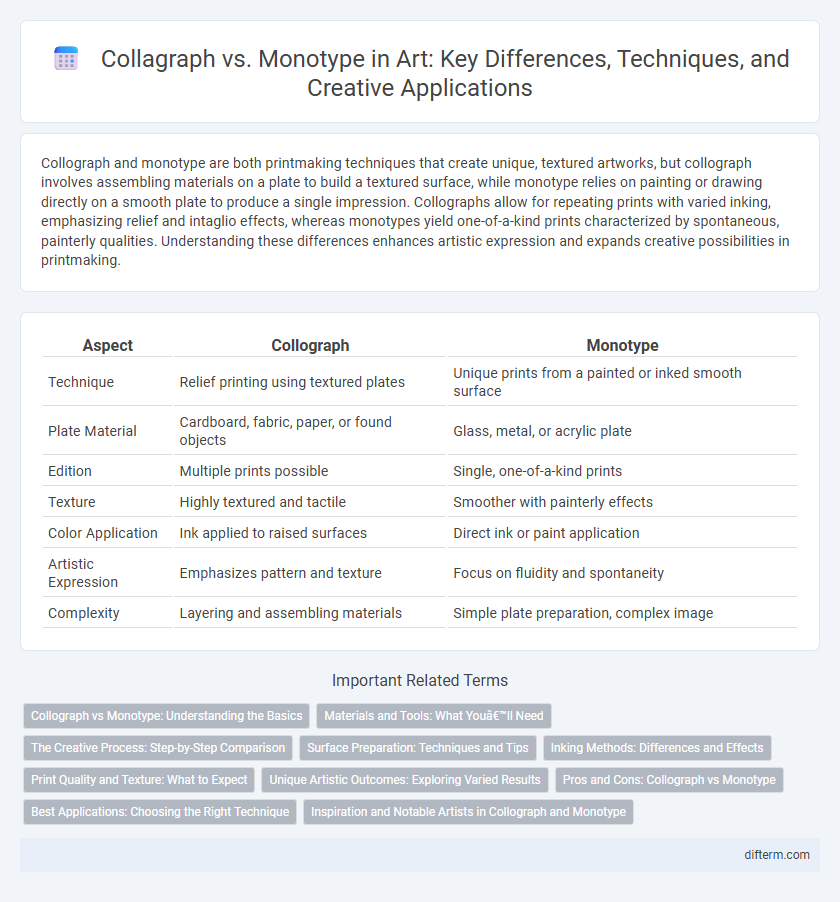Collograph and monotype are both printmaking techniques that create unique, textured artworks, but collograph involves assembling materials on a plate to build a textured surface, while monotype relies on painting or drawing directly on a smooth plate to produce a single impression. Collographs allow for repeating prints with varied inking, emphasizing relief and intaglio effects, whereas monotypes yield one-of-a-kind prints characterized by spontaneous, painterly qualities. Understanding these differences enhances artistic expression and expands creative possibilities in printmaking.
Table of Comparison
| Aspect | Collograph | Monotype |
|---|---|---|
| Technique | Relief printing using textured plates | Unique prints from a painted or inked smooth surface |
| Plate Material | Cardboard, fabric, paper, or found objects | Glass, metal, or acrylic plate |
| Edition | Multiple prints possible | Single, one-of-a-kind prints |
| Texture | Highly textured and tactile | Smoother with painterly effects |
| Color Application | Ink applied to raised surfaces | Direct ink or paint application |
| Artistic Expression | Emphasizes pattern and texture | Focus on fluidity and spontaneity |
| Complexity | Layering and assembling materials | Simple plate preparation, complex image |
Collograph vs Monotype: Understanding the Basics
Collograph and monotype are distinct printmaking techniques valued for their unique textures and artistic effects. A collograph involves creating a textured plate by adhering materials to a surface, which is then inked and pressed onto paper, allowing for repeated prints with consistent patterns. Monotype produces a single, unique print by painting or drawing on a smooth plate and transferring the image in one impression, emphasizing spontaneity and fluidity in art creation.
Materials and Tools: What You’ll Need
Collograph printing requires materials such as cardboard or wood panels, textured items like fabrics or leaves, glue, and printing ink, along with brayers and printing presses for effective ink transfer. Monotype primarily relies on a smooth plate, often made of plexiglass or metal, ink or paint, and tools like rollers or brushes to manipulate the image before pressing paper onto the plate. Both techniques demand high-quality printing papers, but collograph benefits from a more textured surface, while monotype excels with smooth, glossy finishes for optimal image clarity.
The Creative Process: Step-by-Step Comparison
Collograph printing involves building a textured plate using various materials like cardboard or fabric, which is then inked and pressed onto paper for multiple consistent impressions. Monotype creation consists of applying paint or ink directly onto a smooth surface such as glass or metal, followed by transferring a single, unique print to paper with a press or by hand. Both techniques emphasize distinct hands-on processes, with collograph allowing reproducibility and monotype offering spontaneous, one-of-a-kind results, shaping the artist's workflow and creative expression.
Surface Preparation: Techniques and Tips
Collograph surface preparation involves building a textured matrix using materials like cardboard, fabric, or textured papers glued onto a rigid plate, ensuring durable relief patterns for ink retention. Monotype requires smooth, non-absorbent surfaces such as glass or metal plates, enabling direct application and manipulation of ink or paint to create unique, one-off impressions. Proper surface conditioning in both techniques influences ink adhesion and print clarity, with collograph demanding precise layering and monotype benefiting from controlled surface slickness.
Inking Methods: Differences and Effects
In collograph printing, inking involves applying ink to the raised surfaces of a textured plate, creating rich, layered effects with varied textures and depth. Monotype inking employs a direct approach where ink is painted or rolled onto a smooth plate, producing unique, singular impressions with fluid, painterly qualities. These divergent inking methods result in collographs emphasizing tactile surfaces, while monotypes showcase spontaneous brushstrokes and gradients.
Print Quality and Texture: What to Expect
Collograph prints offer rich, tactile texture due to their raised surfaces created from glued materials, resulting in varied ink absorption and a deeply layered image quality. Monotypes produce smoother, more fluid prints with unique, spontaneous textures as the ink is applied directly onto a flat plate and transferred in a single impression. Expect collographs to emphasize depth and relief, while monotypes highlight subtle gradations and painterly effects in print quality.
Unique Artistic Outcomes: Exploring Varied Results
Collograph and monotype printing techniques offer unique artistic outcomes due to their distinct processes; collograph uses textured plates built from materials to create rich, layered impressions, while monotype produces singular images through direct painting or drawing on a non-absorbent surface. Collograph prints tend to emphasize intricate textures and repeatability with variations, whereas monotypes capture spontaneous, one-of-a-kind expressions with fluid, painterly effects. Artists leverage these differences to experiment with surface detail and unpredictability, expanding creative possibilities in printmaking.
Pros and Cons: Collograph vs Monotype
Collograph offers rich texture and detailed relief effects due to its layered materials, making it ideal for artists seeking tactile depth but requiring longer preparation and drying times. Monotype excels in spontaneity and unique, one-of-a-kind prints with smooth gradients and blending, though it lacks repeatability and can be less texturally diverse. Both techniques provide distinct artistic expressions; collograph suits intricate, textured works while monotype favors fluid, expressive compositions.
Best Applications: Choosing the Right Technique
Collograph excels in creating textured, layered prints ideal for artists seeking rich surface variety and tactile depth, making it best suited for experimental and mixed-media projects. Monotype offers unique, spontaneous prints with smooth gradients and fluid forms, perfect for capturing expressive, one-of-a-kind images or painterly effects. Selecting between collograph and monotype depends on whether the artist prioritizes textural complexity or the immediacy of singular impressions.
Inspiration and Notable Artists in Collograph and Monotype
Collograph and monotype techniques inspire artists by offering unique textural possibilities and spontaneous mark-making that fuel creative expression. Notable artists like Diane Keller and Enrique Martinez Celaya have explored collograph's layered textures, while Edgar Degas and Paul Gauguin are celebrated for their innovative monotype prints. These methods encourage experimentation with surface and form, making them enduring sources of artistic inspiration.
collograph vs monotype Infographic

 difterm.com
difterm.com